本文主要是介绍sentinel流控规则详解(图形化界面),希望对大家解决编程问题提供一定的参考价值,需要的开发者们随着小编来一起学习吧!
1、QPS
每秒的请求数,超过这个请求数,直接流控。
2、BlockException统一异常处理
2.1、创建异常返回类
Result.class
public class Result<T> {private Integer code;private String msg;private T data;public Result(Integer code, String msg, T data) {this.code = code;this.msg = msg;this.data = data;}public Result(Integer code, String msg) {this.code = code;this.msg = msg;}public Integer getCode() {return code;}public void setCode(Integer code) {this.code = code;}public String getMsg() {return msg;}public void setMsg(String msg) {this.msg = msg;}public T getData() {return data;}public void setData(T data) {this.data = data;}public static Result error(Integer code, String msg){return new Result(code,msg);}
}2.2、异常处理类
@Component
public class MyBlockExceptionHandler implements BlockExceptionHandler {Logger log= LoggerFactory.getLogger(this.getClass());@Overridepublic void handle(HttpServletRequest httpServletRequest, HttpServletResponse response, BlockException e) throws Exception {// getRule() 资源 规则的详细信息log.info("BlockExceptionHandler BlockException================"+e.getRule());Result r = null;if (e instanceof FlowException) {r = Result.error(100,"接口限流了");} else if (e instanceof DegradeException) {r = Result.error(101,"服务降级了");} else if (e instanceof ParamFlowException) {r = Result.error(102,"热点参数限流了");} else if (e instanceof SystemBlockException) {r = Result.error(103,"触发系统保护规则了");} else if (e instanceof AuthorityException) {r = Result.error(104,"授权规则不通过");}//返回json数据response.setStatus(500);response.setCharacterEncoding("utf-8");response.setContentType(MediaType.APPLICATION_JSON_VALUE);new ObjectMapper().writeValue(response.getWriter(), r);}
}其中的FlowException,DegradeException等异常就是对应的限流,降级的异常。
2.3、测试结果
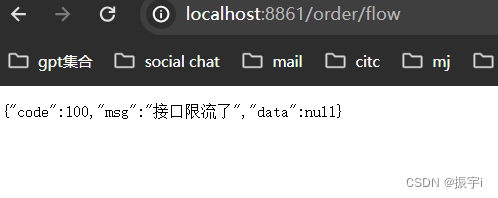
3、对单一的接口/方法流控(使用注解)
使用@SentinelResource注解。
如果需要设置自定义的流控返回信息,则需要再在@SentinelResource
注解中添加blockHandler配置。
注意:blockHandler所对应的自定义方法必须要和流控的接口/方法的返回值与参数一致,然后加上BlockException e,并且BlockException必须引用自com.alibaba.csp.sentinel.slots.block.BlockException


4、关联流控
如图所示,当/order/add超过阈值QPS=1后,/order/flow就会被限流。此举不会流控/order/add
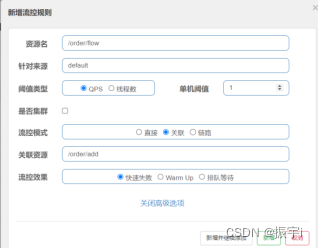
5、链路流控
5.1、开启链路
此版本的Sentinel默认没有开启链路流控,所以需要去配置文件中开启,需要将web-context-unify设置为false,如图:

5.2、链路规则详解
即/test3,/test4接口都用到了getUser方法,对getUser方法进行流控,当超过阈值以后,限制/test3接口调用,不限制/test4接口调用。
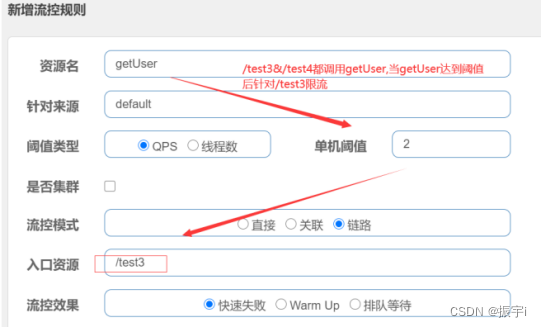
5.3、流控示例
接口:http://localhost:8861/order/test1,http://localhost:8861/order/test2都调用了方法getUser,现在针对test1接口,去实现对getUser方法的链路流控。
因为对业务方法进行流控,所以需要对所要流控的方法加上@SentinelResource
注解,如果需要设置自定义的流控返回信息,则需要再在@SentinelResource
注解中添加blockHandler配置。添加规则如步骤3中所提及。

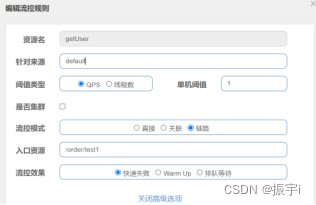
然后,当访问getUser方法超过每秒一次以后,/order/test1接口就会被限流,/order/test2却依旧能正常访问。
6、预热流控
即预热/冷启动方式。当系统长期处于低水位的情况下,当流量 突然增加时,直接把系统拉升到高水位可能瞬间把系统压垮。通过"冷启动",让通过的流量缓慢增加,在一定时间内逐渐 增加到阈值上限,给冷系统一个预热的时间,避免冷系统被压垮。
冷加载因子: codeFactor 默认是3,即请求 QPS 从 threshold / 3 开始,经预热时长逐渐升至设定的 QPS 阈值。
例:如下图,假设阈值为10,那么请求进来时,那么刚开始每秒允许通过3个请求(10/3),然后在5秒内,逐渐把请求放开到十个每秒。
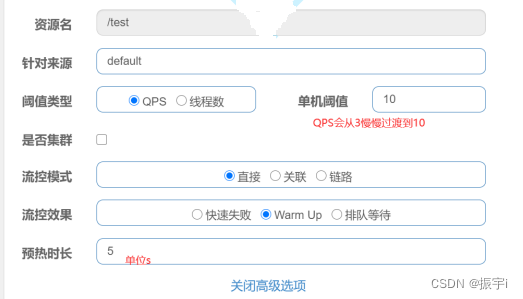
7、排队等待流控
这种方式主要用于处理间隔性突发的流量,例如消息队列。想象一下这样的场景,在某一秒有大量的请求到来,而接下来的几秒则处于空闲状态,我们希望系统能够在接下来的空闲期间逐渐处理这些请求,而不是在第一秒直接拒绝多余的请求。
如图所示,设置阈值为5,排队等待的时间为5秒,假设在0~1秒内进来了10个请求,那么只会放行五个请求,剩下的5个请求不会失败,而是会在2~5内按照阈值来放行。
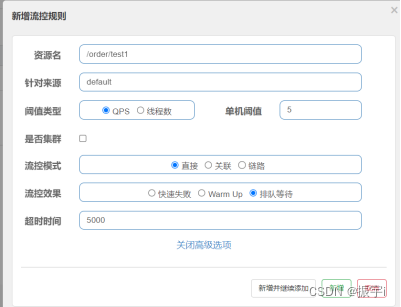
这篇关于sentinel流控规则详解(图形化界面)的文章就介绍到这儿,希望我们推荐的文章对编程师们有所帮助!





